A History of Ontario's Provincial Plaques
The information and black and white photos on this page are courtesy
of the Ontario Heritage Trust.
If you have any information about the history of Ontario's Provincial Plaques that you would like to share, contact me from the link in the menu and I would be happy to add it to this page.
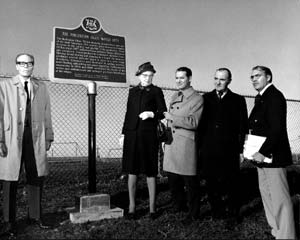
In the 1950s, the Archaeological and Historic Sites Board of Ontario began erecting plaques to stimulate public awareness of, and pride in, Ontario's past. In 1974, the sites board was incorporated into the Ontario Heritage Trust. The Trust assumed responsibility for the plaque program, working in partnership with heritage-minded individuals, community groups and nonprofit organizations throughout the province. Over the years, the variety of subjects commemorated by plaques has increased. Early plaques concentrated on the founding of communities and the province's political and economic heritage. Today, they cover a much broader range of subjects, including science, nature and culture. The Provincial plaque program also identifies important heritage subjects that received little attention in the past - the contributions of First Nations, Franco-Ontarians, other minorities and women in shaping our society. Since 1982, the Trust has provided both French and English text for all new and replacement plaques.
The provincial plaque program is the Trust's oldest and best-known heritage conservation activity. Over 1,100 plaques have been erected, including 22 plaques in Britain, Europe and the United States of America.
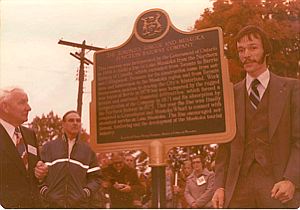
Photo on right courtesy of Brian Westhouse.
Since 1956 when Ontario's historical plaquing program was begun, more than 1,000 markers have been erected throughout the province. The range of subjects commemorated is astonishing; mining rushes in northern Ontario, the invention of the socket-head screw, Harold Innis, Stephen Leacock, the typhus epidemic of 1847 as well as the discovery of insulin. Popular culture is also well represented: "Beautiful Joe" commemorates an internationally successful novel about a dog and "Jumbo" marks the spot where a beloved circus elephant died. The history of Ontario, like its geography and its people, is vast and varied. Whenever you drive the highways, hike the countryside, or stroll through your own neighbourhood, this book can be a guide.
The provincial plaque program is the Trust's oldest and best-known activity. Since 1956, over 1,100 plaques have been erected to commemorate people, places, and events in Ontario's heritage.
 The purpose of the provincial plaque program is to promote an understanding of Ontario's past by interpreting significant heritage subjects at appropriate sites across the province. The program is distinguished by its royal blue and gold markers emblazoned with the provincial coat-of-arms. The Archaeological and Historic Sites Board of Ontario put up the first provincial plaque in 1956. The Ontario Heritage Trust has been responsible for the provincial plaque program since 1975.
The purpose of the provincial plaque program is to promote an understanding of Ontario's past by interpreting significant heritage subjects at appropriate sites across the province. The program is distinguished by its royal blue and gold markers emblazoned with the provincial coat-of-arms. The Archaeological and Historic Sites Board of Ontario put up the first provincial plaque in 1956. The Ontario Heritage Trust has been responsible for the provincial plaque program since 1975. 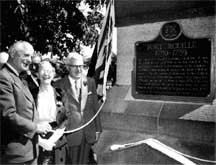 The Trust invites individuals, organizations and communities to apply for provincial plaques. The subject can be a person, place, event, site or structure that represents an important part of Ontario's heritage. Sponsors should be able to demonstrate the subject's historical significance and have a suitable site for the plaque. Sponsors of approved plaques are expected to share the costs involved. However, those who cannot afford to contribute funds may apply for an exemption from the cost-sharing arrangement.
The Trust invites individuals, organizations and communities to apply for provincial plaques. The subject can be a person, place, event, site or structure that represents an important part of Ontario's heritage. Sponsors should be able to demonstrate the subject's historical significance and have a suitable site for the plaque. Sponsors of approved plaques are expected to share the costs involved. However, those who cannot afford to contribute funds may apply for an exemption from the cost-sharing arrangement.
As well as commemorating Ontario's heritage through plaques, the Trust is committed to monitoring its plaques for damage and maintaining them in good condition. If you know of a damaged or weathered provincial plaque, please contact the Trust.
In March 2006 I received an email from John Vanbaal containing some fascinating information regarding the 'Holstein Friesian Cattle in Ontario' plaque. Mr. Vanbaal wrote: Attached is a photo I took today of a plaque that went missing some years ago (25yrs?!!) and was replaced with the current bilingual one. The missing plaque was found discarded some time later a very short distance from the newly replaced one. It's currently at the Lost Villages Museum mounted in the Forbes Reading Room on what was the back door. Text on the new plaque has been edited a bit so they could fit it into a smaller space.
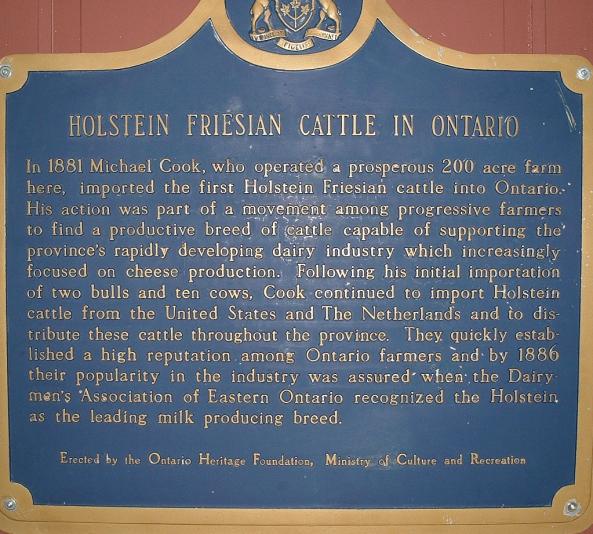
Old plaque photo courtesy of John Vanbaal
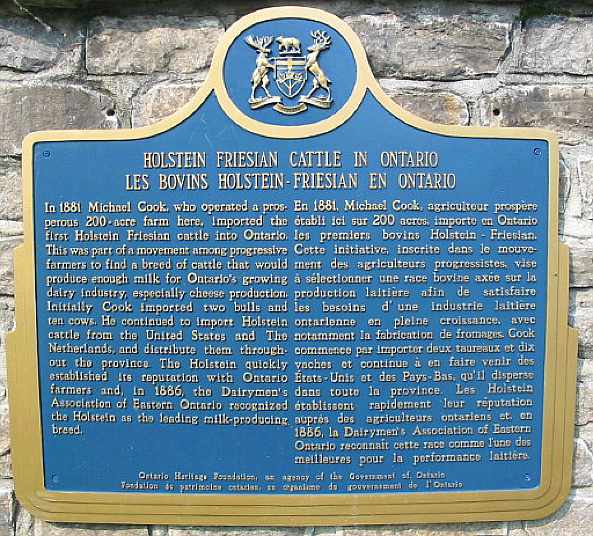
New plaque photo by Alan L Brown